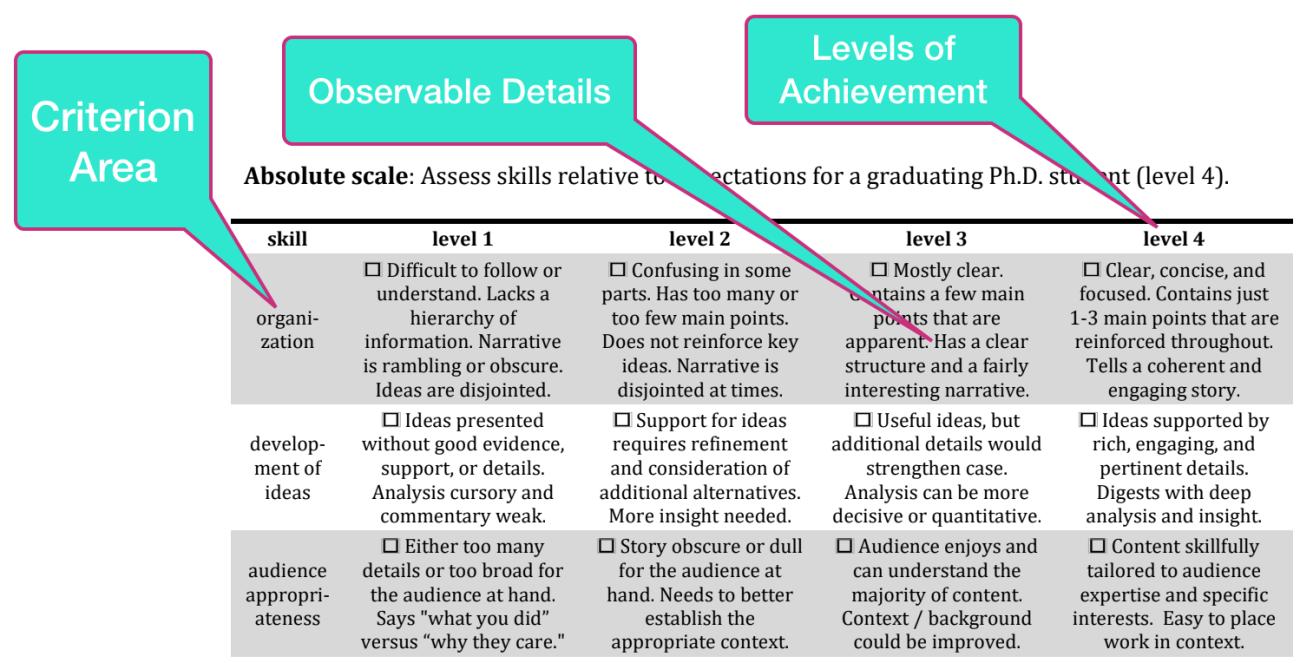Why Rubrics?
A well-crafted rubric provides a concise, targeted description of what your program’s (ideal) learning outcomes look like in (observable) student work. Such a scoring guide also provides a consistent structure for differentiating levels of achievement across students’ work. This helps you as educators in two ways:
- It makes your work easier! Having core criteria, clearly named, on a checklist or scale (as appropriate), allows you or your trained raters to assess what matters to you in student work quickly and effectively.
- It makes your findings useful! Having comparable data on PLOs -- whether across sections of a course taught by multiple faculty, or across years of incoming majors and graduating seniors -- can inform you about where/how a program impacts students.
WARNING! If criteria for PLO achievement are inconsistent, broadly defined, or recorded in loosely structured manner, then results may not be aggregable, may be skewed by subjective variance among those assessing data, or may be laborious and time-intensive to compile -- resulting in incomplete projects, unclear conclusions, and data-collection re-do’s.
Give your assessment plans a strong foundation with a rubric or scoring guide. A little bit of front-end preparation will reward you with more efficient and fruitful assessment projects.

Custom-fitting a Rubric for your Assessment
Rubrics need to be tailored to a program’s educational aims AND the work where student achievement of those aims is evident. So, answer these questions, and you have the basis for your assessment scoring-guide or rubric.
- Outcome (Focus): “What learning outcome are you looking at?” “What question or hypothesis do you have about the program’s impact on student work, related to this outcome?” Have the rubric directly reflect this focus.
- Criteria (Define): “What student work are you examining for direct evidence of PLO proficiency?” Have rubric criterion-areas specifically name the most relevant attributes of these data.
- Levels of Achievement (Describe): For each criterion-point, “What details in that student work denote a level of achievement with the PLO?” “How many levels of achievement will it be Useful for us to distinguish, here?” Make sure to concretely describe those characteristics that matter in students’ work (at each level!), as you assess PLO progress.
- User-friendly Structure (for your Raters): “Is this rubric easy to read quickly, and mark clearly, when assessing student work?” Craft the rubric so that it will intuitively fit in with existing grading protocols in the program and/or its courses.

We are happy to give you support and feedback in crafting your rubrics. Feel free to contact assessment coordinator Josh Kuntzman directly, or look for our yearly Fall workshops on creating rubrics for PLO assessment.
- Political Science (Graduate - TA Teaching Observation)
- French (Undergraduate - Speaking)
- Chemical Engineering (Graduate - Research Proposals)
- Film & Media Studies (Undergraduate - Writing)
- Mathematics (Graduate - Oral Presentation)
- Chemical Engineering (Undergraduate - Lab Report)